Identification of a promising PI3K inhibitor for the treatment of multiple myeloma through the structural optimization
- PMID: 24428908
- PMCID: PMC3924225
- DOI: 10.1186/1756-8722-7-9
Identification of a promising PI3K inhibitor for the treatment of multiple myeloma through the structural optimization
Abstract
Background: We previously reported a PI3K inhibitor S14161 which displays a promising preclinical activity against multiple myeloma (MM) and leukemia, but the chiral structure and poor solubility prevent its further application.
Methods: Six S14161 analogs were designed based on the structure-activity relationship; activity of the compounds in terms of cell death and inhibition of PI3K were analyzed by flow cytometry and Western blotting, respectively; anti-myeloma activity in vivo was performed on two independent xenograft models.
Results: Among the six analogs, BENC-511 was one of the most potent compounds which significantly inhibited PI3K activity and induced MM cell apoptosis. BENC-511 was able to inactivate PI3K and its downstream signals AKT, mTOR, p70S6K, and 4E-BP1 at 1 μM but had no effects on their total protein expression. Consistent with its effects on PI3K activity, BENC-511 induced MM cell apoptosis which was evidenced by the cleavage of Caspase-3 and PARP. Notably, addition of insulin-like growth factor 1 and interleukin-6, two important triggers for PI3K activation in MM cells, partly blocked BENC-511-induced MM cell death, which further demonstrated that PI3K signaling pathway was critical for the anti-myeloma activity of BENC-511. Moreover, BENC-511 also showed potent oral activity against myeloma in vivo. Oral administration of BENC-511 decreased tumor growth up to 80% within 3 weeks in two independent MM xenograft models at a dose of 50 mg/kg body weight, but presented minimal toxicity. Suppression of BENC-511 on MM tumor growth was associated with decreased PI3K/AKT activity and increased cell apoptosis.
Conclusions: Because of its potent anti-MM activity, low toxicity (LD50 oral >1.5 g/kg), and easy synthesis, BENC-511 could be developed as a promising agent for the treatment of MM via suppressing the PI3K/AKT signaling pathway.
Figures
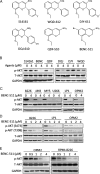
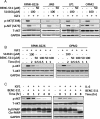
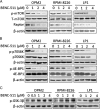


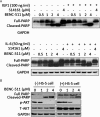
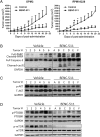
Similar articles
-
A novel PI3K inhibitor displays potent preclinical activity against an androgen-independent and PTEN-deficient prostate cancer model established from the cell line PC3.Toxicol Lett. 2014 Aug 4;228(3):133-9. doi: 10.1016/j.toxlet.2014.05.003. Epub 2014 May 14. Toxicol Lett. 2014. PMID: 24831963
-
A small-molecule inhibitor of D-cyclin transactivation displays preclinical efficacy in myeloma and leukemia via phosphoinositide 3-kinase pathway.Blood. 2011 Feb 10;117(6):1986-97. doi: 10.1182/blood-2010-05-284810. Epub 2010 Dec 6. Blood. 2011. PMID: 21135258
-
A virtual screen identified C96 as a novel inhibitor of phosphatidylinositol 3-kinase that displays potent preclinical activity against multiple myeloma in vitro and in vivo.Oncotarget. 2014 Jun 15;5(11):3836-48. doi: 10.18632/oncotarget.1657. Oncotarget. 2014. PMID: 25003534 Free PMC article.
-
Effects of BENC-511, a novel PI3K inhibitor, on the proliferation and apoptosis of A549 human lung adenocarcinoma cells.Biosci Trends. 2019;13(1):40-48. doi: 10.5582/bst.2019.01006. Biosci Trends. 2019. PMID: 30867372
-
Antimyeloma activity of the orally bioavailable dual phosphatidylinositol 3-kinase/mammalian target of rapamycin inhibitor NVP-BEZ235.Cancer Res. 2009 Jul 15;69(14):5835-42. doi: 10.1158/0008-5472.CAN-08-4285. Epub 2009 Jul 7. Cancer Res. 2009. PMID: 19584292
Cited by
-
Nitroxoline induces cell apoptosis by inducing MDM2 degradation in small-cell lung cancer.Kaohsiung J Med Sci. 2019 Apr;35(4):202-208. doi: 10.1002/kjm2.12051. Epub 2019 Mar 21. Kaohsiung J Med Sci. 2019. PMID: 30896891 Free PMC article.
-
The natural polyphenol curcumin induces apoptosis by suppressing STAT3 signaling in esophageal squamous cell carcinoma.J Exp Clin Cancer Res. 2018 Dec 5;37(1):303. doi: 10.1186/s13046-018-0959-0. J Exp Clin Cancer Res. 2018. PMID: 30518397 Free PMC article.
-
Ubiquitin-specific peptidase 28 enhances STAT3 signaling and promotes cell growth in non-small-cell lung cancer.Onco Targets Ther. 2019 Feb 26;12:1603-1611. doi: 10.2147/OTT.S194917. eCollection 2019. Onco Targets Ther. 2019. PMID: 30881015 Free PMC article.
-
MicroRNA-590-5p antagonizes the inhibitory effect of high glucose on osteoblast differentiation by suppressing Smad7 in MC3T3-E1 cells.J Int Med Res. 2019 Apr;47(4):1740-1748. doi: 10.1177/0300060519830212. Epub 2019 Feb 26. J Int Med Res. 2019. PMID: 30803283 Free PMC article.
-
Ubiquitin specific peptidase 5 regulates colorectal cancer cell growth by stabilizing Tu translation elongation factor.Theranostics. 2019 May 31;9(14):4208-4220. doi: 10.7150/thno.33803. eCollection 2019. Theranostics. 2019. PMID: 31281542 Free PMC article.
References
-
- Cantrell DA. Phosphoinositide 3-kinase signalling pathways. J Cell Sci. 2001;114(Pt 8):1439–1445. - PubMed
Publication types
MeSH terms
Substances
LinkOut - more resources
Full Text Sources
Other Literature Sources
Medical
Molecular Biology Databases
Research Materials
Miscellaneous

